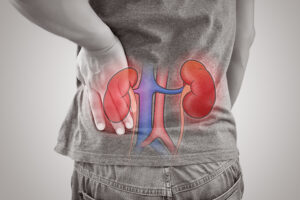Chronic Kidney Disease
Chronic kidney disease (CKD) is a serious, long-term condition that affects the way the kidneys work. About 37 million adults in the United States have CKD, according to the National Kidney Foundation. Millions of others are at risk.
The kidneys are two bean-shaped organs located at the back of the abdomen, with one on each side of the spine. Each kidney is about the size of a computer mouse.
Every day, a person’s kidneys clean about 200 quarts of blood, filtering out waste products and other fluids to form urine. The kidneys also make hormones that help control blood pressure, make red blood cells, and maintain bone health.
CKD occurs when the kidneys no longer work the way they’re supposed to. When this happens, fluids and wastes can build up in the body and cause illness.
CKD is often linked to other health conditions, such as diabetes, high blood pressure, and heart disease. It’s also progressive, which means it gradually gets worse. For these reasons, it’s critical to be diagnosed early and follow treatment plans exactly.

CKD occurs when the kidneys no longer work the way they’re supposed to. When this happens, fluids and wastes can build up in the body and cause illness.
What causes CKD?
A number of conditions can cause kidney damage and lead to CKD. Diabetes and high blood pressure are the two leading causes.
Diabetes
High blood sugar can damage blood vessels, including blood vessels in the kidneys. When this happens, the kidneys can’t work properly.
In addition, diabetes can cause nerve damage, which can make it hard to empty the bladder. If the bladder becomes too full, urine can back up into the kidneys. High blood sugar in the urine can also lead to kidney infections.
High blood pressure
When a person has high blood pressure (also called hypertension), there is too much force on blood vessel walls. If this happens in kidney blood vessels, the pressure interferes with kidney function.
Other conditions that can cause kidney disease include the following:
- Glomerulonephritis. This group of diseases can cause inflammation to the kidney’s filtering units (called glomeruli).
- Polycystic kidney disease. This inherited disease causes cysts (sacs filled with fluid) to form in the kidneys.
- Birth defects. If the kidneys or urinary tract don’t form correctly in the womb, there could be kidney damage later.
- Autoimmune diseases. When a person has an autoimmune disease, their immune system mistakes healthy cells for diseased cells and attacks them. One example is lupus nephritis, which causes inflammation.
- Obstructions in the urinary tract. Kidney stones, tumors, and an enlarged prostate can block urine flow, leading to kidney damage.
- Urinary tract infections (UTIs) and kidney infections (pyelonephritis). Repeated infections may damage the kidneys.
- Interstitial nephritis. This condition causes inflammation in the kidneys.
- Vesicoureteral reflux. This condition can cause urine to flow backward from the bladder up to the kidneys.
What are CKD risk factors?
People may be more likely to develop CKD if they have:
- Diabetes
- High blood pressure
- Heart disease
- A family history of kidney disease
- Obesity
Other risk factors include older age and smoking. In addition, CKD is more common in ethnic groups that have higher rates of diabetes or high blood pressure. These groups include African Americans, Hispanic Americans, Asian Americans, Pacific Islanders, and American Indians.
According to the Centers for Disease Control and Prevention (CDC), chronic kidney disease affects about 14% of women and 12% of men.
CKD symptoms

People with CKD don’t always have symptoms at first. It’s possible that if one kidney is damaged, the other kidney can compensate for a while.
Eventually, however, symptoms do occur. They may include:
- Nausea or vomiting
- Swelling (edema), especially in the feet and ankles
- Puffiness around the eyes
- Dry skin
- Fatigue
- Headaches
- Weakness
- Sleep issues
- Poor appetite
- Muscle cramps
- Urinating more or less than before
- Poor concentration
- Chest pain
- Shortness of breath
How is CKD diagnosed?
To diagnose CKD, doctors start with a physical exam, take the patient’s medical history, and discuss any current symptoms.
Other testing may include:
Blood urea nitrogen (BUN) test
When the kidneys filter blood, they remove a waste product called urea nitrogen. A BUN test checks for this substance. If the level is high, it could mean kidney disease is present.
Creatinine test
Creatinine is another waste product that can be found in the blood. High levels of creatinine indicate that the kidneys are not working as well as they should.
eGFR
Doctors use results of the creatinine test, along with a person’s age, sex, and body weight, to determine the estimated glomerular filtration rate (eGFR). This value gives doctors an idea of how well the kidneys are functioning, and it helps with staging CKD. The higher the eGFR rate, the better the kidneys are working.
Albumin urine test
Albumin is a protein in the blood. Normally, the kidney does not filter it out. But if a kidney is damaged, some albumin may be filtered from the blood to the urine.
Imaging tests
Doctors may conduct a kidney ultrasound or CT scan to visually check the kidneys and urinary tract. These tests can show whether there is a problem with kidney structure or if a person has a kidney stone or tumor.
Biopsy
During a biopsy, doctors use a special needle to remove small samples of kidney tissue. The samples are examined under a microscope.
Stages of CKD
Doctors use diagnostic test results and the eGFR to stage CKD.
Stage 1: There is some kidney damage, but the eGFR is in a normal range.
Stage 2: Kidney damage and eGFR reduction are mild.
Stage 3: Kidney damage and eGFR reduction are mild to moderate.
Stage 4: Kidney damage and eGFR reduction are moderate to severe.
Stage 5: End-stage kidney disease (kidney failure). At this stage, dialysis (either hemodialysis or peritoneal dialysis) or a kidney transplant are needed for survival.
Treatment for CKD

When treating CKD, doctors aim to slow down the progression of the disease, manage symptoms, and give the patient the best quality of life possible. Treatment strategies usually focus on the underlying problem causing the kidney damage. Decisions are made based on the patient’s stage of kidney disease and other health considerations.
Medications
Drugs like angiotensin-converting enzyme inhibitors (ACE inhibitors) or angiotensin II receptor blockers (ARBs) may be prescribed to lower blood pressure. These medicines may also slow down the progression of CKD.
Diuretics (“water pills”) may be prescribed to help move extra fluid out of the body and manage blood pressure.
Changes in diet
People with kidney disease may need to follow a low-sodium diet or watch how much protein, phosphorus, or potassium they consume. Patients may consider talking to a dietitian, who can help them learn about meal planning for CKD.
Lifestyle changes
In addition to eating well, other healthy lifestyle habits may slow the progression of CKD. These include:
- Controlling blood pressure
- Controlling blood sugar
- Taking steps to quit smoking
- Getting enough physical activity
- Maintaining a healthy weight
- Getting enough sleep
- Managing stress, depression, and other mental health issues
- Taking medications as directed
- Drinking less alcohol
Dialysis
When a person reaches end-stage kidney disease, their kidneys can no longer function on their own and need help filtering the blood. Dialysis is one option.
There are two types of dialysis:
Hemodialysis
Blood is removed from the body through an access site. It is then filtered by a special machine, and the cleaned blood is returned to the body through the access site. Hemodialysis might take place several times a week. Some people have their treatment at a dialysis center. Others have hemodialysis at home.
Learn more about hemodialysis here.
Peritoneal dialysis
This type of dialysis uses the peritoneum (tissue that lines the abdomen) to clean the blood. Patients put a cleaning solution called dialysate into the peritoneal cavity through a catheter.
The dialysate stays in the body for several hours before it’s drained out of the body, through the catheter, and into a waste collection bag. It’s then replaced with fresh dialysate. This process repeats several times during the day.
Some people manage the process of peritoneal dialysis manually, adding and draining dialysate themselves at home or another convenient place. Others use a machine called a cycler, which handles the process for them while they sleep.
Learn more about peritoneal dialysis here.
Kidney transplant
A kidney transplant is another option for people with end-stage kidney disease. The damaged kidney is surgically removed and replaced with a healthy kidney from a donor. Once the new kidney is in place, the patient takes immunosuppressive drugs to keep their body from rejecting the new kidney.
Complications of CKD
Patients may also need treatment for complications of CKD, such as the following:
- Heart disease
- Anemia
- High blood pressure
- Fluid retention and swelling, especially in the legs
- Gout
- Nerve damage
- Itchy skin
- Weak bones
- Pericarditis (inflammation of the pericardium, the membrane that surrounds the heart)
- High levels of phosphorus or potassium in the blood
- Metabolic acidosis (too much acid in the body)
- Imbalance of calcium, vitamin D, and phosphorous, which may cause bone problems
Follow-up
With any kind of CKD treatment, it’s important for patients to have regular follow-up visits and physical exams with their doctor. Through routine blood, urine, and imaging tests, doctors can monitor patients’ progress and make any needed changes in treatment.
Reducing the risk for CKD
People who are at risk for CKD should be tested regularly. They can also take good care of their kidneys by:
- Eating healthy foods
- Staying hydrated
- Getting enough exercise and sleep
- Making plans to quit smoking
- Keeping blood pressure and blood sugar in normal ranges
- Taking medications exactly as prescribed
- Seeing a doctor regularly
Resources
American Academy of Family Physicians
“Chronic Kidney Disease (CKD)”
(Last updated: August 2022)
https://familydoctor.org/condition/chronic-kidney-disease-ckd/
American Kidney Fund
“eGFR Test Change: Removal of Race from the Calculation”
(January 3, 2023)
https://www.kidneyfund.org/all-about-kidneys/tests/egfr/egfr-test-change-removal-race-calculation
“Health problems caused by kidney disease”
(No date provided)
https://www.kidneyfund.org/living-kidney-disease/health-problems-caused-kidney-disease
“Stages of kidney disease”
(Last updated: October 26, 2022)
https://www.kidneyfund.org/all-about-kidneys/stages-kidney-disease
Centers for Disease Control and Prevention
“Chronic Kidney Disease in the United States, 2023”
(Last reviewed: May 30, 2023)
https://www.cdc.gov/kidneydisease/publications-resources/CKD-national-facts.html
“Get Tested for Chronic Kidney Disease”
(Last reviewed: May 27, 2022)
https://www.cdc.gov/kidneydisease/publications-resources/get-tested.html
Cleveland Clinic
“Diuretics”
(Last reviewed: October 1, 2021)
https://my.clevelandclinic.org/health/treatments/21826-diuretics
“Kidney”
(Last reviewed: May 17, 2022)
https://my.clevelandclinic.org/health/body/21824-kidney
“Urethra”
(May 5, 2022)
https://my.clevelandclinic.org/health/body/23002-urethra
Mayo Clinic
“Chronic kidney disease” (Diagnosis and Treatment)
(September 3, 2021)
https://www.mayoclinic.org/diseases-conditions/chronic-kidney-disease/diagnosis-treatment/drc-20354527
“Chronic kidney disease” (Symptoms and Causes)
(September 3, 2021)
https://www.mayoclinic.org/diseases-conditions/chronic-kidney-disease/symptoms-causes/syc-20354521
MedlinePlus
“BUN (Blood Urea Nitrogen)”(Last updated April 5, 2022)
https://medlineplus.gov/lab-tests/bun-blood-urea-nitrogen/
National Institute of Diabetes and Digestive and Kidney Diseases
“Chronic Kidney Disease (CKD)”
(Last reviewed: October 2016)
https://www.niddk.nih.gov/health-information/kidney-disease/chronic-kidney-disease-ckd/all-content
“Managing Chronic Kidney Disease”
(Last reviewed: October 2016)
https://www.niddk.nih.gov/health-information/kidney-disease/chronic-kidney-disease-ckd/managing
“Your Kidneys & How They Work”
(Last reviewed: June 2018)
https://www.niddk.nih.gov/health-information/kidney-disease/kidneys-how-they-work
National Kidney Foundation
“Angiotensin-converting enzyme (ACE) inhibitors & angiotensin receptor blockers (ARBs)”
https://www.kidney.org/atoz/content/angiotensin-converting-enzyme-ace-inhibitors-angiotensin-receptor-blockers-arbs
“Chronic Kidney Disease (CKD)”
https://www.kidney.org/atoz/content/about-chronic-kidney-disease
“Diabetes - A Major Risk Factor for Kidney Disease”
https://www.kidney.org/atoz/content/diabetes

